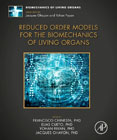
Reduced Order Models for the Biomechanics of Living Organs
Chinesta, Francisco
Cueto Prendes, Elías
Payan, Yohan
Ohayon, Jacques
Reduced Order Models for the Biomechanics of Living Organs, a new volume in The Biomechanics of Living Organisms series, provides a comprehensive overview of the state-of-the-art in biomechanical computations using reduced order models, along with a deeper understanding of the associated reduction algorithms that will face students, researchers, clinicians and industrial partners in the future. The book gathers perspectives from key opinion scientists who describe and detail their approaches, methodologies and findings. It is the first to synthesize complementary advances in Biomechanical modelling of living organs using reduced order techniques in the design of medical devices and clinical interventions, including surgical procedures. This book provides an opportunity for students, researchers, clinicians and engineers to study the main topics related to biomechanics and reduced models in a single reference, with this volume summarizing all biomechanical aspects of each living organ in one comprehensive reference. Introduces the fundamental aspects of reduced order models Presents the main computational studies in the field of solid and fluid biomechanical modeling of living organs Explores the use of reduced order models in the fields of biomechanical electrophysiology, tissue growth and prosthetic designs INDICE: Part 1: Backgrounds and Fundamentals of Reduced Order Models (3 Chapters) 1. Model Order Reduction with special emphasis in PGD 2. Model Order Reduction with special emphasis in Reduced Bases 3. Model Order Reduction: from fundamentals to biomedical applications Part 2: Applications to Computational Solid Biomechanics (9 chapters) 4. Model order reduction for left ventricular mechanics via congruency training 5. Simulation of hyperelastic materials in real-time using deep learning 6. A model order reduction approach to create patient-specific mechanical models of human liver in computational medicine applications 7. Real-time simulation of biological soft tissues: a PGD approach 8. Real-time Simulations of human tongue movements with a Reduced Order Model of a Non-linear Dynamic Biomechanical Model 9. A finite element-based machine learning approach for modeling the mechanical behavior of the breast tissues under compression in real-time 10. In situ parameter identification of optimal density-elastic modulus relationships in subject-specific finite element models of the proximal femur 11. Rapid identification of elastic modulus of the interface tissue on dental implants surfaces using reduced-basis method and a neural network 12. Simulation Tools for Biomechanical Applications with PGD-Based Reduced Order Models. Application to femoral bone Part 3: Applications to Computational Fluid Biomechanics (6 chapters) 13. Improved Reduced-Order Modelling of Cerebrovascular Flow Distribution by Accounting for Arterial Bifurcation Pressure Drops 14. Reduced Order Models for Transstenotic Pressure Drop in the Coronary Arteries 15. Transversally enriched pipe element method (TEPEM): An effective numerical approach for blood flow modeling 16. Model reduction techniques for fast blood flow simulation in parametrized geometries 17. A Reduced-Order Modeling for Efficient Design Study of Artificial Valve in Enlarged Ventricular Outflow Tracts 18. A Reduced-Order Model for Wall Shear Stress in Abdominal Aortic Aneurysms by Proper Orthogonal Decomposition Part 4: Applications to Biomechanical Electrophysiology, Growth and Designs (6 Chapters) 19. Multifidelity-CMA: A multifidelity approach for efficient personalisation of 3D cardiac electromechanical models 20. Predictive prosthetic socket design 21. System Identification in Tumor Growth Modeling Using Semi-empirical Eigenfunctions 22. Numerical Model Reduction for the Prediction of Interface Pressure Applied by Compression Bandages on the Lower Leg 23. Reduced Order Models, Forward and Inverse Problems in Cardiac Electrophysiology 24. Computational vademecums for real-time simulation of surgical cutting in haptic environments
- ISBN: 978-0-323-89967-3
- Editorial: Academic Press
- Encuadernacion: Cartoné
- Páginas: 400
- Fecha Publicación: 01/03/2023
- Nº Volúmenes: 1
- Idioma: Inglés
